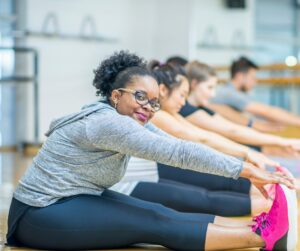Whether you’re new to ballroom dance or a seasoned competitor, taking care of your body is just as important as mastering your technique. At Fred Astaire Dance Studio in Gilbert, we believe in helping our students dance longer, stronger, and pain-free. Injury prevention and dancer health aren’t just for professionals—every dancer should prioritize safe practices both in and out of the studio.
Here’s your complete guide to warming up, stretching, preventing injuries like shin splints and ankle sprains, and keeping your body in peak condition for dancing.
Why Injury Prevention Matters in Dance
Dance is an incredible full-body workout, but it also puts unique demands on your muscles, joints, and tendons. Repetitive movements, fast footwork, and improper technique can lead to strain or injury if your body isn’t properly prepared.
Common dance injuries include:
- Shin Splints: Pain along the shinbone, often caused by repetitive impact on hard floors.
- Ankle Sprains: A common injury from landing improperly or rolling the ankle during turns or jumps.
- Hamstring Pulls: Often the result of overstretching or inadequate warm-up.
- Lower Back Pain: Poor posture or tight hip flexors can contribute to chronic discomfort.
Fortunately, most dance-related injuries are preventable with the right routines and body awareness.
How to Warm Up Properly Before Dance
Warming up isn’t just about getting your blood pumping—it’s about preparing your muscles and joints for movement. A good warm-up should last 5–10 minutes and include the following:
- Light Cardio: Try jumping jacks, brisk walking, or jogging in place to elevate your heart rate.
- Dynamic Stretching: Instead of holding a stretch, move through a range of motion. Arm circles, leg swings, and hip rotations help improve mobility without overstretching cold muscles.
- Foot and Ankle Mobility: Roll your ankles, flex and point your feet, and do simple calf raises to prep for dancing on your toes.
Warming up helps activate your core, increases circulation, and reduces the risk of strain during more intense movement.
Essential Stretches for Hamstring Flexibility
Tight hamstrings are a common complaint for dancers. Flexible hamstrings improve range of motion and posture and even reduce stress on the lower back. Try incorporating these stretches into your post-dance cooldown:
- Standing Hamstring Stretch: Place one foot on a low surface (like a bench), keep the leg straight, and hinge at the hips. Keep your back flat and avoid bouncing.
- Seated Forward Fold: Sit on the floor with legs extended and gently reach toward your toes.
- Lying Hamstring Stretch with Strap: Use a towel or yoga strap around the ball of your foot and gently pull the leg toward you while lying on your back.
Hold each stretch for 20–30 seconds, and avoid pushing to the point of pain.
Recognizing and Preventing Common Dance Injuries
Let’s take a closer look at two common injuries dancers face—and how to avoid them:
1. Shin Splints
Causes: Repetitive jumping or dancing on hard floors without proper footwear or support.
Prevention Tips:
- Wear supportive dance shoes with cushioned insoles.
- Cross-train with low-impact exercises like swimming or cycling.
- Strengthen your calves and ankles with toe taps and resistance band exercises.
2. Ankle Sprains
Causes: Quick directional changes, poor landing technique, or weak stabilizing muscles.
Prevention Tips:
- Do balance training like standing on one leg or using a balance board.
- Strengthen your ankles with resistance bands and heel-to-toe walking drills.
- Always warm up before turns, jumps, or fast footwork.
If an injury occurs, follow the R.I.C.E. method (Rest, Ice, Compression, Elevation) and consult a medical professional if pain persists.
Caring for a Dancer’s Body Year-Round
Dance training can be intense, so it’s essential to maintain your health both in and out of the studio.
- Hydration: Dehydration can lead to muscle cramps and fatigue. Drink water before, during, and after dancing.
- Nutrition: Fuel your body with a balance of protein, healthy fats, and complex carbs to support energy and recovery.
- Rest Days: Schedule at least one rest day a week to allow your muscles to repair and grow stronger.
- Massage or Foam Rolling: Use a foam roller to release muscle tension, especially after long sessions.
Dance Safely at Fred Astaire Dance Studios in Gilbert
At Fred Astaire Dance Studios in Gilbert, your health and progress matter to us. Our instructors emphasize proper technique, safe movement patterns, and personalized attention to help every dancer thrive—without the risk of injury.
Ready to dance confidently and comfortably? Contact us today at (480) 993-0977 to schedule your beginner dance lesson, and let’s keep you dancing stronger for longer!

